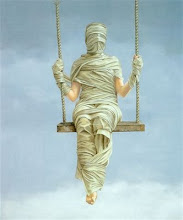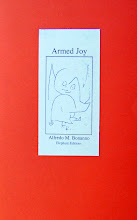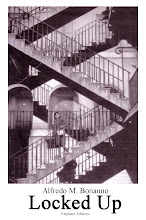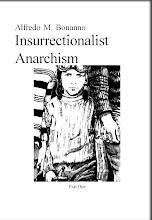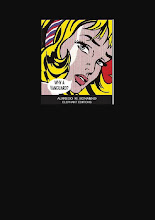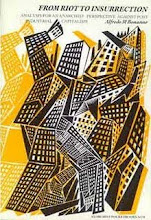If we want to go beyond critique (even violent) of social and economic reality and enter the realm of transformation (including the necessary destruction) we must immediately move on to quite a different terrain. The protagonists of the struggle must have our active complicity in putting together the elements necessary to intensify the attack on the enemy and extend the struggle informally, horizontally. Action must encompass the aims that are to be achieved, i.e. always be in the logic of the destruction of power of all colours, in both its formal and relational manifestations. In such a reality what is required are minimal structures that turn the organisational question upside down. It is only from such elementary organisms born within the struggle itself that the latter will be able to go forward and develop its latent self-organising capacity. These forms could be referred to as base nuclei which are ‘not a gymnasium of the revolution... perhaps not even an adequate instrument of struggle...but could become the grain of sand that jams the machinery of capital’. (p. 23)
One of the great problematics of any liberatory moment is that the protagonists of the struggle grasp the reality of the situation in order to make ethical choices without hesitation when required. The single elements of the eternal triangle rebellion, repression, reform, are not always easily distinguishable the one from the other, the boundaries between them never being absolutely clear and distinct.
The texts we are presenting here have been uprooted from the context of struggle in Italy in the seventies and eighties, a time where these realities were all present. Capitalist restructuring had led to widespread social discomfort, and the movement which ensued had a wide ‘mass’ composition along with the presence of highly politicised, predominantly Leninist extraparliamentary organisations. Various insurrectional situations developed where there was a conscious presence of anarchists. Their aim was not to convince the exploited to become anarchists like them, but to contribute insurrectional anarchist methods to intermediate struggles. At times, however, it was necessary to give people a brief outline of what anarchists want, hence the origins of the final sketch ‘What are anarchists?’, given out by Catania anarchist group Rivolta e Liberta in a specific situation. In those days revolution sometimes seemed just around the corner...
However, we are still here, proposing a different reading of these texts. The old structures have disappeared into oblivion, the new ones are less easily distinguishable, but not for that mean less danger for the spirit of freedom. The question is not to turn to the past but to reflect on age-old problems with a new, revolutionary imagination and creativity projected into the future, which in many ways is far more complex than those far off days only a few decades ago.
J.W.
THE REVOLUTIONARY STRUGGLE
To study methods of revolutionary struggle without first having a clear idea of what we mean by revolution can be extremely dangerous and could lead to quite disconcerting consequences.Unfortunately this mistake has often been made. The Leninists in particular have repeatedly come out with concepts that are applicable to war in general, often influenced by reading Clausewitz, or a Lenin who read Napoleon, Clausewitz, Moltke, von der Goltz, Frederick the Great, etc. Hence all the conclusions relative to a dialectic of war and peace, which in the best of cases is very far-fetched. What is even more serious, this leads to an eminently authoritarian concept of revolution, seen as the coming out of a particularly gifted personality or an elite of particularly gifted people with a strategic plan similar to that of traditional warfare, which they carry through to victory. Those who have ended up on this road are men such as Caesar, Napoleon, Trotsky, Mao-TseTung, all fabricators of victories which came to nothing in their need for results at any cost.
In this way the revolution becomes a theoretical problem, and the revolutionary struggle a question of strategy. In a recent book Cesare Milanese saw Lenin and Trotsky studying the origins of the ‘revolutionary ideas of Bolshevism’ together at the British museum in the years between 1900-1903 as though they were somehow sowing the seeds of future victories.
It is clear, at least for us, that with such prospects a methodology of revolutionary struggle becomes no more than a military manual whereas, if anything, it should be a manual for militants. There is a considerable difference between the two. The military man in the traditional sense of the term is merely an object who must obey orders and die, the militant in revolutionary terms is a subject who must think and, if necessary, also die. It is therefore impossible to suggest or impose on the latter precepts which would be acceptable only to the first.
Now the fundamental error is lack of faith in the constructive capacity of the masses, hence the revolutionary individual believes in having to work, albeit in the depths of the British museum, not in the latter’s interests but in place of them, independently of any consideration of their presence. They don’t realise that revolution is not just a warlike event, it is also, and principally, a human and social one. All this inevitably leads to new and more terrifying authoritarian structures.
It is quite true that an active minority can carry out preventive clarification. But to go from this to considering their action as something separate from the social context, from the effective situation of the masses—as in the case of a science of revolutionary war that is valid in absolute—seems quite absurd to me.
It is not at all true that methods of revolutionary struggle can grow from an abstract conception of the latter. To think in this way is misleading concerning the real significance of revolutionary methodology. That is why, before examining methods, it is necessary to clarify a few points: the concept of revolution, the alternative (only apparent) between violence and nonviolence, and the (concrete) alternative between authority and freedom.
The concept of revolution
Never has any term been more controversial. Even fascists have spoken of revolution. The climb to power by the Bolsheviks in Russia is considered revolution, and the French revolution is considered to be that of the Rights of Man. Different and contrasting situations, different periods, different problems but persistence in the use of the same word with all the consequences that this entails.
The revolution is a change of values, not a banal modification of norms. With the revolution new situations, new institutions are born and past conditions and privileges are destroyed as a climate of justice and equality comes to take the place of the preceding one of tyranny and social division. But this schema corresponds little to an effective analysis of the elements necessary to determine a modification in the situation of privilege following the revolutionary event.
Here a disturbing component appears on the scene making a linear application of the revolutionary principle, which everyone agrees is of a libertarian nature, impossible. A look at this component reveals two defective situations, one that is typical of the active minority, the other that is typical of the masses. The first is determined by the fact that the active minority, who should be the first to have clear ideas, do not have them at all and often get tangled up in immediate prospects, easy solutions and come to agreements with elements that are only revolutionary in appearance and in fact are fundamentally counter-revolutionary. The second is determined by the fact that the masses have submitted to the constrictions of authority for too long so are not able to accept the new anti-authoritarian structure like a bolt from the blue. If we add to this the forces of the residual reaction and the inability to foresee the construction of a truly revolutionary organisation with essentially functional and not structural or pyramidal concepts, we should have some idea of the problems involved.
That is why the task of the active minority must be to transform the atmosphere and prepare it for the struggle against authoritarian ideologies. In other words, to prepare for revolution. In order to do this it is necessary to fight a violent system with means that are violent. There is no alternative. Our fighting must not be a blind writhing of exasperation, but a rational blow with a cold precise look at our enemy. Without hesitation but without hatred, which would not only cause more damage than good, but undermine the whole revolutionary process on a moral level.
The alternative between violence and nonviolence
As we have said, these alternatives are illusory as the doctrine of nonviolence does not exist in reality. The latter is merely a degeneration of the principle of defensive violence or a simple play of words as there is merely recourse to violence with a banal sophism. When the Indian disciples of the great theoretician of nonviolence surrounded a reactionary who wanted to force them to accept his demands, let us say following a strike, and enclosed him in a circle leaving him bareheaded in the midday sun, they were using one of the techniques of nonviolence. So we are sure that there is no alternative whatsoever to the theory of revolutionary violence intended as defensive violence for anyone who wants to fight and destroy a system of infamy and shame.
We are convinced that only a violent revolution will be able to solve the social problem at the stage in which countries in various parts of the world today have been determined or at least influenced by the acute phase of bourgeois or State capitalism.
But there is no need to believe that revolutionary violence, simply because we define it ‘defensive’ must necessarily be used after the forces of reaction have unleashed their offensive, have attacked the revolutionary forces or, even worse, put a preventive counter-revolution in to effect. It would be pure suicide to think this.
Revolutionary violence is preventive organisation and preventive attack on the bourgeois forces. It is the struggle against State institutions, it is the specific search for confrontation, aimed at the surrender of the State superstructure. Revolutionary violence is initiative, the preparation of guerrilla organisations, the formation of the forces of resistance, and the thinking out of new programmes of attack. Nevertheless revolutionary violence is still defensive violence. In fact the institutions, the State, the bourgeois structure, the military repressive forces, the police and every other expedient put into effect by the shrewd pillage organised by the bosses, is in itself a provocation, an attack, a sentence, a systematic blow. Even when all these repressive forms take on the loose aspect of dialogue and tolerance, even when we feel a familiar hand on the shoulder, precisely then is the moment to strike harder, more deeply.
The generating strength of revolutionary violence must be considered at the base of every attempt to liberate the oppressed, it being unthinkable for the authentic mechanisms of economic and political factors to determine the maturity of the revolutionary situation on their own. It needs the will of men, their predetermined conscious actions, their violent actions directed against institutions.
The alternative between authority and freedom
But the breaking up of values caused by the revolution can go in two directions. The first is the authoritarian one, favoured by the fact that the revolutionary moment is more chaotic than anything, giving little time for reflection. It is a moment in which situations strengthened by men’s will intersect with situations created by the power of things and the economic and political structures. The presence of the old authoritarian ideological structure, most often the fruit of the bourgeois organisational and productive structures, cannot be eliminated easily. If to this situation is added the presence of people who are unprepared for anti-authoritarian solutions, people with little faith in the possibility of the self-determination of the masses, one can understand why the possibilities of an authoritarian development of the revolution are many,
There remains the other direction, the anti-authoritarian one. A more conscious, difficult direction. Not so much because the objective situations determined by prevalently economic factors are in contrast with this kind of solution as because the active minority may not have the necessary faith in the masses that this solution requires, making them feel entitled, for the superior aims of the revolution, to put themselves in their place. It is here that the great incomprehension that we took up at the beginning of these pages lies. The superior aims of the revolution no longer exist when it is betrayed by the authoritarians, when the initial anti-authoritarian vision becomes compromise with governmental structures under the vestiges, let us say, of a dictatorship of the proletariat.
Unfortunately today in the present state of anti-bourgeois libertarian development with its flourishing of doctrines and pseudo-revolutionary tendencies, expectations of an immediate anti-authoritarian revolution do not appear favourable. In any case the conscious participation of forces within the liberation movement, their constant and documented actions in favour of an education to freedom, and their increasing opening towards the elimination of sectarianism, are all elements which will open the way to a libertarian presence and action within future anti-authoritarian revolutionary solutions. The post-revolutionary struggle of tomorrow will be even harder than that of today, but that must not scare us. The road to the real revolution could also pass through the authoritarian or pseudo-revolutionary one.
The question of the difference between ‘violence’ and ‘nonviolence’ is usually posed wrongly because of the class interests and emotive reactions it triggers off.
State violence and the terrorism of the bosses knows no limits or moral obstacle. Revolutionaries, and anarchists in particular, are quite justified in responding to this violence with revolutionary violence.
Complications arise when we examine the positions of those who support nonviolence. In appearance only do they choose peaceful methods, which when seen in isolation are not violent, i.e. do not physically attack the adversary. When seen within the general framework of the struggle, their interventions (apart from those of organisations who use nonviolence as an alibi to leave things as they are) turn out to be just as violent as those carried out by the supporters of ‘violence’.
A march of ‘pacifist’ demonstrators is itself a violent event which upsets the order of exploitation. It is a demonstration of strength, a show of force. It does not differ from the ‘violent’ demonstration, at least in the choice of objective. From the strategic and revolutionary point of view, the idea of a violent demonstration capable of winning and holding a military victory is unthinkable today. In so saying, we do not mean that we should refuse revolutionary violence. We only mean we must be clear so as to avoid sanctifying the machine gun on the one hand or becoming the policeman of the situation on the other.
A purely verbal distinction between violence and nonviolence is a false one. A well-fed bourgeois can easily ‘theorise’ the most unchained violence against the boss class but only with difficulty will he put it into effect in conditions requiring total dedication to the revolutionary task. Most often his violence is purely verbal. In practice he prefers things to remain as they are because, among other things, that allows him to continue to exercise his fiery rhetoric.
Another equally well-fed bourgeois might feel himself transported to an exaltation of nonviolence, but still as something theoretical, something condemning the negative ‘instincts’ of struggle and violence and sanctifying the positive ‘instincts’ of peace and brotherhood. Only with difficulty however will this bourgeois put his nonviolent ‘principles’ into practice in a total daily involvement in the social struggle. He will prefer the comfort of the situation as it is, where he can carry on with his reflections on peace and brotherhood.
Before speaking of violence and nonviolence a distinction should be made as to whether the question is being applied to a real situation, or whether it is simply an abstract theory and there is no intention of actually applying it. Only in the case of the former is it possible to discuss the strategic and military conditions that render nonviolent methods less effective and more easily overcome by power. But this discussion is one which comes afterwards, it is a question of method and never an abstract one.
We are not interested in philosophical discussions on violence that lead to theories of the hereditary biological violence of the species, etc., which stink of theology. What is important is to approach the struggle in its reality. The rest is a question of choice of means and the best way to put them into effect.
If we are personally convinced that nonviolent methods are unsuitable in the social struggle today, not for this are we against the comrades who see their own dimension of struggle in nonviolent methods. What is important is that the struggle be engaged in seriously, that it not be limited to speaking of ‘nonviolent struggle’ as an alibi so that the police will leave us alone.
Abstract discussions on violence (nearly always fiery and bloody) and just as abstract discussions on nonviolence (nearly always idiotic and paradisiacal) are equally disgusting. We can only respond effectively to the historic crime of exploitation, terrorism, and institutionalised violence with struggle, using any means we choose. The violence (or nonviolence) of words and speeches will change nothing.
AUTONOMOUS BASE NUCLEI
Analysis of instruments of struggle cannot leave out of consideration an evaluation of the conditions under which the struggle is taking place. To prepare an instrument that is capable of attacking and defeating the project of the bosses therefore requires an analytical effort that goes beyond what the mere technicalities of the instrument might lead one to suppose.
Autonomous base nuclei are minimal instruments of intervention in the reality of the struggle. They are the smallest organisational form, which allow one to reconstruct—at the level of the revolutionary—individual tissue which always runs the risk of tearing on contact with daily solicitations. An old or a new instrument of struggle? The answer is not simple. The long history of exploitation sees the stubborn reappearance of forms which often come to be rejected at certain phases in the struggle, only to re-emerge then be rejected once again. Only an outsider would see these ‘returns’ as mere revarnished trophies of the past. In substance, an instrument of struggle takes on a meaning (not just a ‘new’ meaning) when it establishes a meaningful relationship with the level of the clash in course. In the case of the contrary not only will it not be a ‘new instrument’, it will not be an instrument at all, merely a conditioned reflux of power itself.
The spectacular phase of capitalist dominion is tending to recede today. The element of representation which allowed for the transferral of life to within preestablished limits of the rhythms of exchange, transforming man and his things into symbolic abstractions, has taken the form of repetitiveness. Relations of exchange in which a presumed harmony was reached have now become repetition, changing not only the relationship of man and his things within the process of production, but also that of man and time. With the coming about of the dominion of repetitiveness time is stored, packaged.
Let us take two borderline cases. The organisation of production was aimed at the ‘make believe’ of a world where violence entered the spectacle of the elimination of violence within the harmony of production. The factory was a miniature model of the harmonious society where social conflicts were resolved in the approximate (but always satisfactory) resolution of the bosses’ technical problems. Production took on fideistic aspects. Commercial exchange came to be lived through the rationalisation of scientific knowledge. The spectacle of production became the spectacle of harmony. Not only did it serve to create the conditions of established order, it became possible to ‘believe’ in the existence of the latter, and its universal value. The typical worker complied with these conditions of existence perfectly and, in exchange for a part of the social product, accepted the defence of his own state of servitude. Those who were excluded by the process of differentiation which capital renders indispensable, summed up their rage in terms of ‘lack of acceptation’, leading to violent destructive explosions and progressive englobing to within the area of wage earning.
Another minority proclaimed itself within this spectacle: the seekers of fire, forefathers of the present day negators of any condition of exchange. Reference to the drug addict is obligatory. The seeker of fire, as well as belonging to a restricted minority, constituted the most coherent response to the formal dominion of capital and its representative spectacular order (dominion). Like the factory, the consumption of drugs required a very closed framework, an obligatory place where wealth was produced or destroyed (which is the same thing). To drug oneself openly would have been unthinkable, just as production ‘islands’ or working days organised as one wanted was. Money was the maximum form of the meaningful, either in the abstract form of actual wealth or as an instrument of spectacular exchange.
The factory and the opium den both required the spectacle of the exorcizing of violence. The mythical sacrifice was consumed (and in many ways is still consumed in more backward conditions of capital) to prevent real explosions of violence.
Let us look at the second borderline case. Production is no longer simply aimed at ‘making believe’ in a world of values which, beyond the spectacle of absurd preestablished harmony, has no sense whatsoever. A more immediate, measurable aim is being programmed, that of repetitiveness. No longer the reassembling of qualitative contrasts in a fictitious global harmony, but a summing up of uniformities. If once one was pushed to buy a TV, now one is pushed to buy whole TV programmes, the stock of sports, cultural, culinary, musical, etc., programmes. The model of value is precisely this accumulation. The equivalent of consumerism will be drowned in this generalised need for unity of product. Clothes will all be the same, cars all the same, films all the same, sexual acts all the same, gestures, words all the same. The very capacity to grasp differences will weaken to the point of disappearing. Comic strips educated us a long time ago concerning the magic of reiteration. We do not enjoy a strip of Charlie Brown for its novelty but for the way its novelty dialogues within an absolute, mortifying repetitiveness. The same goes for Diabolik. Special prisons apply this technique to the full: they are no longer places where blood spatters the walls, but where the obsessional repetition of gestures has almost completely taken the place of the blood-curdling representation of the torture of the past. Repetition is an incredible factor in the scale of integration between production and consumption. Once separate moments from within the representative cycle of exchange, today the latter unite to the point of confusing themselves the one with the other. In this way power normalises the different, centralises the specific, homogenises the dissociated.
The majority of them (again the drug addict cannot be left out) are no longer seekers of fire. The will to penetrate the unknown is spent. There is no longer a search to open up levels of experimentation: repetitiveness has taken the place of representation. Capital no longer needs to ‘make believe’, now it can simply keep quiet, pushing people to produce/consume to be ‘like the others’ and not in order ‘to distinguish themselves from others’. By consuming the consumer reproduces himself as such, belonging to a social group of consumerism/production, no longer isolated individual/consumer/producer. Identity only renders intelligible the differences between social groups, not those within the group itself. There is no longer any shame attached to wearing, in thousands, the same pair of jeans. On the contrary, acceptation of this uniformity—which has been programmed by capital—is sought after and considered with a kind of fascination which the search for the different never had in the past.
Now let us face the second part of this text, that aimed at looking into the operative conditions of the instrument of struggle we have referred to as autonomous base nuclei. The spirit of revolutionary syndicalism always present somewhere in these autonomous organisational forms seems, in the face the changing conditions of capital, destined to disappear. A struggle at the level of claims takes for granted a dialogue with the bosses on the basis of a possible readjustment of wage contrasts. The mistake made in the past was to consider engagement in that direction positive, because a positive outcome gave a wider field of action to the producers themselves. This has now been channelled by capital first towards the sacrificial representation of the negation of violence, then towards the homogenisation of the behaviour of consumer/producer.
That does not mean denying the validity of permanent conflict. The class clash marks the drastic limit beyond which lies the bloody mist of reactionary interclass collaboration. It is just that our enemy has mined the road with traps and it is important not to fall into them. One of these traps is the nullification of the increase in real wages. It is not true that it is possible to buy more with a wage increase, the same things are simply bought at a higher price. But the trap is that one buys the ‘same things’. Moreover, the greatest trap is that we are happy and content to buy the same things that others buy.
The unification of the equation production/consumption allows for the realisation of a struggle front as never before. Today the figure of the ‘privileged producer’, the worker who saw himself as different to the disinherited or lumpenproletarian no longer exists. At the technical level of production such distinctions are still operative but they are disappearing. Hammering on the need for repetition, power has obtained the great result of detaching privileged producers from consumer goods which were ‘luxuries’ compared to the increasingly large minorities, resulting in outbreaks of social conflict that are increasingly difficult to control. It has also had to pay the price of opening the road to a recomposition of the class front. The decomposition of production (and therefore of consumerism), the so-called crises, should have far more serious effects now than in the phase of formal dominion where the process of representation was able to keep productive strata separate from those excluded from wage earning. A sudden break up of uniformity could produce phenomena of mass rebellion compared to the little hysterical crises which came about in the opium dens of the past.
Claims for real wage increases are coming to be made in a different way however, obliging the institutions of class dominion to give in on the question of nominal increases. From individual appropriation to collective expropriation, from bad work to techniques of absenteeism, from collective reduction to collective destruction, from sabotage to public denunciation, from counter-information to the search for one’s capacity to self-organise: everything must be used in an anti-boss dimension. But the vital element of transformation must be in the attempt to destroy the grandiose apparatus of repetitiveness, the homogenisation of the individual. In breaking up this repressive apparatus one endangers the very relationship consumption/production and the minimal conditions for attack are realised, allowing one to safeguard the creativity of the struggle.
The mythology of the past: the logo, the slogans, the ‘analyses that explained everything’, sacred monsters of a time which seemed close to the revolution, must be substituted with inventiveness, simplicity, modesty, awareness of one’s limitations and one’s possibilities. A nucleus is not a gymnasium of the revolution, it is not the point of reference which will overcome the order of capitalism, perhaps it is not even an adequate instrument of struggle, but it could become all this and far far more: it could become the small grain of sand that jams the machinery of capital.
LOOKING FORWARD TO SELF-MANAGEMENT
1. The problem of self-management is not just the technical problem of how to ensure the functioning of production before, during and after the revolution. It is a more complex problem that involving the very dynamic of the revolutionary process. To study possible models of self-management without putting them in a revolutionary context means nothing at all as far as liberation is concerned.
To ask the meaning of self-management means to ask how a society entrusted into the hands of the producers would function. But at the same time it means asking if it is possible to self-manage the struggle at the present time, in the face of exploitation and genocide.
Self-management of the struggle comes first, followed by self-management of work and society.
If self-management is to serve State production, then we are against it. If it is to serve as an instrument for deceiving the workers yet again, we are against it. If it is to serve as an alibi for some party to come to power on the backs of the masses, we are also against it.
2. The exploited will bring about the revolution because they are trapped and suffer the progressive loss of every positive aspect of social life. The mass movement is developing on the deterioration of the economic, social and cultural conditions which rendered the preceding State administration possible. The work of stimulus and clarification which the revolutionary minority is carrying out is part of this contradictory structure, soliciting the autonomous strength that exists within the masses, pushing them to construct the rudiments of self-managed organisation which, starting off from the struggle, can extend to the formation of generalised self-management through the self-managed revolutionary event.
3. In the waning phase of consumerism world economic power tried to use the Yugoslavian type model of self-management on a large scale. Such a solution would have been of very great danger to the workers’ movement. If they had fallen into the trap they would have accepted the management of the places of production (only those most easily controllable, never the fundamental ones such as the banks, finance companies, railways or shipping lines), controlled by a bureaucratic political centre or in the hands of party leaders—technocrats in the service of a capitalism that has been rendered absolutely anonymous— or under some new kind of charismatic leader.
There would have been self-management in name alone. The workers, under the imperatives of a programming centre, would merely be self-managing their own exploitation. Strikes, for example, would be unthinkable when not specifically forbidden. This self-management would be equivalent to the militarisation of production.
4. In order to give themselves a perspective of self-management workers must first oppose themselves to the present structure of collaboration between the various elements involved in their exploitation. These are: a) the political parties, including those who define themselves ‘left-wing’ and consider themselves the carriers of the revolutionary tradition; b.) the unions, including those who refer to revolutionary syndicalist doctrines and to anarcho-syndicalism.
The presence of this triple alliance, bosses, parties and unions, is pushing workers to build the bases of their own autonomy and conquer the essential elements necessary for taking the first steps towards self-management. This does not so much mean an advance in the level of the struggle as a qualitative leap which is attempting to attack the anti-worker alliance brought about by the forces of reaction and their collaborators. It is the class situation in its complexity which is being put in question and examined in a new light. Workers’ autonomy is the first step towards self-management.
5. Another essential phase in the perspective of self-management is workers’ reappropriation of their creative capacity. The capitalist system, basing itself on the private ownership of the means of production, does not allow for the creative employment of those means by the worker. The activity of production is distorted and produces the phenomenon of alienation: production escapes the worker. His work is well and truly forced labour.
But the creative capacity of the working man or woman can only be recovered through the availability of the product, that is through a revolutionary process of reappropriation when a reactionary process of exploitation is in force. Revolution of work is therefore the self-managed organisation of these first elements of the future society, base production nuclei which grow from the autonomy of the struggle.
6. Information is a key element in the model of future exploitation. Moments of crisis in imperialist consumerism can be overcome by allowing co-management carried out while maintaining absolute control over information. Any form of counter-information, any deviation from the data supplied by the central direction would be carefully excluded. What is known as ‘preventive censure’ is a means of globalizing the process and of causing the fragmentation of the working class, thereby eliminating the nonproductive strata (controls, timekeepers, etc.), and reducing the importance of some of the intermediate strata (civil servants, etc.).
In this reactionary situation the element of struggle which fits in perfectly within the perspective of workers’ self- management is the conquest of information. The workers organise information themselves, from the base, taking over its elaboration and interpretation, refusing the participation of any intermediary whatsoever to act as a filter—in the first place, of course, the unions.
7. The project of self-management begins to take form through the essential points we have listed: a) workers’ autonomy, b.) recovery of the creative capacity, c) the conquest of information. It remains to be seen how this will come about, i.e. if by spontaneous germination within the workers’ movement due to the effect of certain structural changes, or by an intervention prepared by a precise minority.
In our opinion the action of an anarchist minority within the mass fits in very well with the perspective of self- management. This does mean the hypothesis of a ‘guide’ who, in any case would end up repeating social democracy’s programme. It means action within the workers’ movement itself, seeking to coordinate autonomous organisations in accordance with the interests of the workers, and aimed at safeguarding individual autonomy in the dimension of class autonomy.
8. The presence of an anarchist minority within the mass considers the problem of the choice of instruments in the struggle. We attack the interclassist and reformist parties, but not for this do we fall into a stale supporting of spontaneity. The points of reference are the workers’ interests which they must recognise as such. A change in structure, when based entirely on economic factors, does not necessarily mean an ‘automatic recognition’ of the latter. For example, a struggle for an increase in wages led by the unions is not always in the interests of the workers. It may be in their ‘apparent’ interests. On the contrary it may be in the ‘effective’ interests of their exploiters. Understanding this is the necessary foundation for the self-management of the struggle and therefore for the firm establishment of the prospect of self-management.
The choice of means for the struggle, for example direct action, sabotage, the destruction of work, carries a need for clarification and an identification of the ‘real interests’ of the working class. The need for this work cannot be denied by an unfounded voluntaristic view of the phenomenon.
Recognition of one’s own interests is the most important condition for the realisation of the social revolution.
9. Past forms of struggle such as cooperatives, factory councils, rank and file committees, sectorial committees, etc., that have been tried out in different historical situations and under other types production relations, must undergo severe analysis.
In substance, the limitations of these forms are demonstrated in the fact that capitalist society still exists. The workers must analyse with precision the negative effect which this alienating situation has on instruments which in themselves contain valid elements of cooperation and self-management. For example, cooperatives can only produce—as they are organised today—an autarchic and corporative spirit, a spirit which denies the class struggle and every sentiment of solidarity. Whoever thinks differently, and believes that from cooperatives can grow the seeds of a future society, mutual aid for the benefit of all, is illuding themselves in that they are attributing to capitalism not only a utilizable technological component, but also a psychological component of self-management which, in our opinion, does not exist.
10. The passage from the pre-revolutionary period to the revolution, and therefore to the construction of a new society, cannot come about in a sudden brusque way, unless care has been taken to construct the essential elements of a self-managed structure of the struggle. Self-management precedes the revolution, it is not a consequence of it.
If self-management were to be considered in its productive aspect alone, there would be a temptation to bring it about separately from the self-management of the struggle, resulting in the delegation of the struggle to a specific body (armed wing of the proletariat), to a specific party (workers’ party), or to a precise minority in government (democracy in general). Capitalism is extremely interested in this choice being made by the workers’ movement and it is exactly in this direction that it has been pushing it with all the means at its disposal, in particular by a massive use of the media. We must not fall into the trap.
By placing the organisation of the struggle alongside the organisation of production in the perspective of self-management, reactionary and capitalist forces are automatically expelled from the field of action of the workers’ movement. In fact, capital could never manage a struggle led by the workers autonomously, the instruments usually employed (parties and unions) would become useless in such a situation.
11. The revolutionary project is based on the existing relationship between producer and product. In this relationship other elements exist which affirm and modify it at the same time without transforming it radically. Clearly this relationship must be egalitarian, that is each according to his needs and from each according to his possibilities. It must be organised from the base, otherwise it will not be egalitarian. And it must be simple and elementary, that is it must spread to the abolition of the market mechanism which deforms needs as well as the economic aspect of production.
With self-management of the struggle organised from the base in small nuclei of workers at the level of production attacking the centres of exploitation, a movement of cohesion for a development of the conflict through the conquest of information could reach the definitive expropriation of capital, i.e. the revolution.
The self-management and independence of organisms of struggle means at the same time independence of the organisation of production. It is impossible to make a difference between the two.
12. The prospect of self-management must be built carefully today, avoiding all the errors inherent in a separation between self-management of the struggle and self-management of production. The first to be interested in this separation are precisely the capitalists. If self-management of the struggle is separated from its logical consequences (self-management of production) the conscious minority of the proletariat become tired and disheartened. It leaves them in a confrontation with no outlet and drives them to remain in the ‘comfortable’ perspective suggested by the parties and unions. Separating self-management of production from its logical premise (self-management of the struggle), another important result is obtained for capital—emptying self-management of its revolutionary meaning, increasing production and profits, safeguarding institutions, and having the working class once again in the hands of the parties and unions.
Unity of the workers in the autonomy of the struggle, unity in the perspective of self-management, unity in the process of revolution and production. These are, in our opinion, the essential points of a correct analysis of self-management.
WHAT ARE THE ANARCHIST
Who do anarchists struggle against
- Against the State seen as the centralised organisation of power in all spheres (administrative, financial, political, military, etc.)
- Against government which is the political executive organ of the State and makes all decisions concerning repression, exploitation, control, etc.
-Against Capitalism which can be considered both as the flux of productive relations in course and individual capitalists, their activity, their projects and their complicity in this form
- Against the individual parts that the State and capital are divided into. In other words the police, judiciary, the army, school, newspapers, television, trade unions, the large multinational firms, etc.
- Against the family, which forms the essential nucleus upon which the State structure is based
- Against the world of politics, therefore against political parties (all of them), Parliament which is the expression of bourgeois democracy, and the political ideology which serves to mask real social problems
- Against fascists and all the other instruments of repression used by the State and Capital
- Against religion and the Church which constitute a potent ally to repression
- Against the army which is an armed force that is used against the people
- Against prisons which institutionalise the repression of the poorest of the exploited classes
- Against asylums which repress the different
What false ideas do anarchists struggle against
- Against reformism which wants to set social problems right by using laws, political parties, parliaments, referendums, votes, etc.
- Against efficientism which wants to reduce man to an automat always capable of working and obeying
- Against humanitarianism which calls for peace and safety of an abstract idea of man but does not act concretely to attack class enemies
- Against nonviolence which blocks the just violence of the exploited which is their only arm of liberation
- Against patriotism which feeds the absurd idea of the homeland in preference to other nations, whereas the exploited have no homeland but are brothers of the exploited of the whole world
- Against militarism which justifies the function of armies with the swindle that their role is the defence of the homeland
- Against racism which defines a part of the human race as inferior
- Against male chauvinism which reduces women to sex objects
- Against feminism which closes itself within an asphyxiating inverted male chauvinism
- Against the delegate which separates the exploited from direct action
- Against hierarchy which educates towards social stratification
- Against obedience which represses all individuality
- Against authority which prevents the autonomous development of the individual
- Against progressivism, a modern version of evolutionism which is the ideological covering of reformism
- Against economism which puts the economics at the centre of the history of class exploitation
-Against trade unionism which is the direct product of economism and which means to limit the class struggle to claiming at the level of the workplace. Anarcho-syndicalism, with all its revolutionary declarations does not escape this reformist limitation
What anarchists want
- Abolition of the State, Government, Capitalism, the family, religion, the army, prisons, asylums and every form of power which uses the law to force others to do something. Therefore refusal also of any kind of workers’ or socialist State and of any form of dictatorship of the proletariat
- Elimination of the private property of land, the tools of labour, materials, machines, factories, the land and anything else required for the production of what is necessary in order to live
-Abolition of salaried work and reduction of work to a minimum organised by individual groups federated on the basis of their own aptitudes and sympathies as well as on the basis of their own needs
- Substitution of the traditional family with life in common based on love and reciprocal affinity and on the basis of real sexual equality
- Organisation of life, such as that of production, based on free associations differing according to the problems to be faced, interests to be defended and affinities to be developed. The whole of these organisations federated on a local basis, by groups of communes, then widening the relations to a larger federation until it reaches the maximum possible of the liberated areas of the revolution
- Education free and aimed at an awakening of individual aptitude which in a liberated society will be meaningful only in the limits in which this liberation is realised
- The spreading of atheism and anti-religious propaganda, always necessary because on these problems even the liberation that has come about cannot exercise more than a limited clarification
- Completion of the social revolution until all domination of man over man be abolished.
The means anarchists want to use
- The specific anarchist organisation which is an active minority of conscious individuals who share personal and political affinity and give themselves the aim of calling on the exploited to organise themselves with a view to revolution.
- A federation of different anarchist groups who while changing nothing of their particular specific structure, link with each other with informal, federative pacts in order to better coordinate their own action
- Propaganda to explain through books, pamphlets, newspapers, leaflets, graffiti, etc. what the intentions of the ruling structure are and the dangers facing the exploited. Also to supply indications of the anarchist struggle and show who anarchists are, or to urge the exploited to rebel, denouncing the consequences of obedience and resignation
- The struggle to claim better conditions - Although we are not reformists, the struggle to obtain improvements in one’s immediate situation (wages, habitation, health, education, occupational, etc.) sees anarchists present although they do not see these moments as ends in themselves. They push the exploited towards this form of struggle so that they can develop the elements of self-organisation and refusal of the delegate which are indispensable in order to develop direct action at all other levels
- Violent struggle to realise the social revolution along with the exploited. The attack against the class enemy (State, government, capital, church, etc.) must necessarily be violent, in the case of the contrary it would only be a sterile protest and would determine a reinforcement of class dominion. This attack could be:
a) isolated attacks against individual structures or people who are responsible for repression
b) an insurrectional attack by a specific minority
c) a mass insurrectional attack
d) a mass revolutionary attack
Each of these levels, starting from the first, may or may not create the conditions leading to the successive one to develop. Political and economic analyses can foresee this possibility within certain limits, but cannot give an absolute response: action itself is the only test for action. The moral foundation of violent struggle already exists in the fact of repression as it has been exercised by power for centuries.


